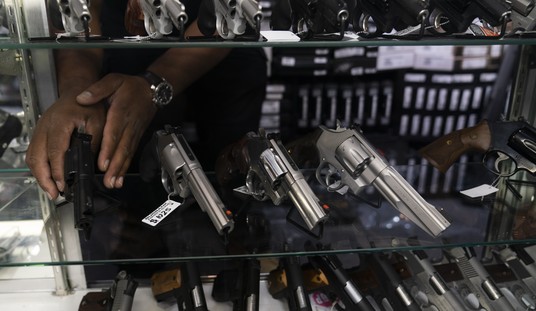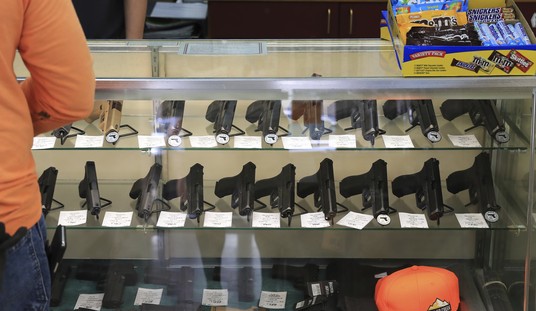A poorly-trained NYPD officer was convicted of manslaughter and official misconduct yesterday in the negligent discharge death of a innocent citizen in a housing project stairwell:
Officer Peter Liang, who shot and killed an unarmed man in a New York housing project stairwell in 2014, was found guilty of manslaughter and official misconduct on Thursday.
As the verdict was read, Liang dropped his head — his hands around the back of his neck — as one of his attorneys comforted him.
The highly unusual conviction of a police officer for the shooting death of a civilian means the rookie cop is automatically fired from the force.
Kimberly Ballinger, the partner of the victim, Akai Gurley, 28, dabbed tears and later pumped her fist in the air.
“He was a son. He was a brother,” Brooklyn District Attorney Kenneth Thompson said after the verdict. “I told his mother, I’m sorry. There are no winners. This is a tragedy all over.”
In a news release, Thompson added the decision was not a verdict against all officers of the NYPD, but one who ignored his official training.
District Attorney Thompson, you’re wrong.
While Peter Liang was convicted, New York City’s cheapskate government and gutless NYPD brass are just as guilty as Liang in Akai Gurley’s death. They put a poorly trained officer on the street with a gun that has no forgiveness built into it.
The NYPD has long had a problem with negligent discharges due to a combination of poor training and poorly-chosen equipment. NYPD officers are typically drawn from the New York metropolitan area, where civilian handgun ownership is actively discouraged by both culture and law, ensuring that the first time most officers touch a handgun is in the police academy. While there, they receive minimal weapons manipulation training, minimal time on the firing line, and training that is both antiquated and unrealistic.
Officers like Liang are then allowed to use one of the worst possible handguns for a poorly-trained officer, the Glock 19 with a “New York” trigger. The configuration roughly doubles the factory trigger pull weight to “break” a shot, but doesn’t lengthen the trigger pull or require it to be any more deliberate.
Combine a poorly-trained officer with a gun that is just as easy to negligently discharge, with a trigger pull weight that makes it more difficult for poorly-trained officers with poor skills to fire intentional shots with accuracy, and you have the recipe for disaster that ensures NYPD officers will be shooting innocent bystanders in negligent discharges and with off-target intentional shots meant for someone else for years to come.
The NYPD didn’t adopt the Glock 19 because it was a good gun (thought it clearly is in well-trained hands). They adopted the Glock 19 because it was all but given away (Glock’s agency pricing is very aggressive). The NPD then tried to mitigate the lack of training they provide their officers with a heavier trigger.
That’s not the problem.
“Heavier” makes it more difficult to accurately place aimed shots, but the trigger pull distance to fire a shot is the same as any standard-length Glock trigger.
Officers who haven’t been competently trained to keep their fingers off the trigger in the first place (and the 20% who put their fingers on the trigger under stress despite their training, FLETC, 2004 (PDF) are still going to fire shots when startled, or in Liang’s case, when they experience parasympathetic response. It is a physiological fact that your hands attempt to mirror one another; clench one hand, the other reflexively follows. In that sad incident in the apartment building stairwell, Officer Liang had his pistol in one hand while doing a vertical patrol, his finger on or near the trigger of his Glock 19. When he reached to open the stairwell door, he encountered more resistance than he anticipated. He compensated to open the stuck door by clinching harder with both hands.
Boom.
Liang was clearly guilty of the negligent discharge, but his bosses in city government and the NYPD bear the blame of giving him a gun that has been consistently linked to higher levels of negligent discharges in the hands of questionably-trained shooters than other semi-automatic pistols dating back to the 1980s through today.
Combine a firearm featuring a relatively short trigger pull, with consistently inadequate training of officers drawn from a pool of recruits where “gun culture” is actively discouraged, and you have recipe for disaster where officers will continue to shoot citizens and themselves with boring and predictable regularity.
* * *
Across the country, Paradise, California police officer Patrick Feaster was finally fired and charged after one of the most morally-depraved negligent discharges you’re ever likely to see.
Feaster began to pursue suspected drunk driver Andrew Thomas, but Thomas rolled the vehicle he was driving seconds after Feaster turned in behind him. We described what happened next in an earlier article.
Feaster is in pursuit of Thomas, but it’s unclear whether or not Thomas was aware that Feaster was behind him. The first we clearly see of Thomas’s SUV is when it has already flipped and is sliding to a stop at :54 into the film.
Feaster’s police cruiser comes to a halt a short distance from the the SUV. Thomas’s wife Darien Ehorn has been ejected from the vehicle and is critically injured or already dead directly in front of the overturned vehicle (her image is blurred out in the video).
At 1:05, you see the first clear signs of Mr. Thomas beginning to emerge from the SUV, which is laying on it’s side. He puts both hands up through the shattered side door window and presses down with both arms to lift himself up.
At 1:07 you see Officer Feaster enter the left side frame of the camera with his hand on his pistol. As Thomas presses down to propel himself up and out of the vehicle, Officer Feaster draws his pistol, extends it directly at Thomas and presses off a single shot at 1:08 as soon as his arm reaches full extension, as captured below.
A clearly unarmed Thomas, shot once through the spine, drops as if axed back through the window into the vehicle.
Feaster immediately holsters his weapon and moved past Ehorn without appearing to even glance at her, then peered down into the SUV at the crumpled Thomas from 1:13 to 1:22. He steps back, grabs his flashlight from his duty belt, and then steps forward again to look at Thomas some more. At 1:33, he finally keys his mike to report, “I’ve got an unresponsive female and a male in the car refusing to get out.”
Officer Feaster doesn’t attempt to help either Ehorn, dead or dying at his feet, nor Thomas, whom he’d just shot. He instead stands there with his flashlight and sweeps the ground with it… perhaps looking for the shell casing from the round he’d just expended.
Two other officers arrive and quickly assess the situation. One almost immediately puts on nitrile gloves and begins chest compressions on Ehorn in an effort to keep her heart pumping blood until the paramedics arrive.
Feaster and the other officer peer into the SUV as the third officer continues chest compressions on Ehorn.
The dash camera runs until 6:35. The one officer appears to be attempting to save Ehorn life throughout, and Feaster and the third officer make some attempt to peel away with sunroof and the windshield of the SUV with their hands, but they simply lack the tools to do so.
4-6 minutes after the dashcam video concluded, Officer Feaster finally tells someone that he discharged his weapon.
In total, Feaster didn’t tell anyone he’d fired a shot for 11 minutes.
Incredibly, Butte County District Attorney Mike Ramsey refused to press charges for the shooting. Thomas, paralyzed by the Feaster’s negligent discharge with a Glock 21C, died several weeks later as a direct result of his wound.
After an investigation apparently spurred more by community outrage than any real desire to seek justice by Ramsey, Feaster has finally been charged.
Former Paradise police officer Patrick Feaster was arraigned Wednesday in Butte County Superior Court on a charge of manslaughter, more than two months after he shot an unarmed man suspected of drunken driving.
Feaster, 31, appeared in Judge James Reilley’s court at 8:30 a.m., after District Attorney Mike Ramsey decided to bring manslaughter charges against the former officer. Feaster was charged with a single felony count of involuntary manslaughter while armed.
Feaster, dressed in a dark-colored suit, did not enter a plea.
The charges come two days after Paradise Police Chief Gabriela Tazzari-Dineen announced Feaster was no longer on the payroll. The chief said she couldn’t say whether Feaster was fired because of state law outlined by the Peace Officers’ Bill of Rights.
When asked by a reporter whether Feaster quit or was fired, Ramsey said only that Feaster did not resign.
The official story from Ramsey’s office was that Feaster was “extensively trained” with his Glock 21C. Presuming that Ramsey is correct, then perhaps Feaster is another example of the 20% of officers who put their fingers on the triggers of their guns, despite training.
If that is the case, the death of Andrew Thomas, like the death of Akai Gurley, would seem to suggest that law enforcement officers should be equipped with handguns featuring a trigger pull that requires more deliberation (not as the NYPD got wrong, more weight) to fire.
Double-action/single-action guns like the Beretta 92 series work well for law enforcement, as do Sig Sauers pistols, but they require a little more training to adjust from the slightly longer, heavier trigger pull to the shorter, lighter following shots.
Perhaps a light double-action trigger, such as Sig Sauer’s DAK or HK’s LEM (law enforcement modification), is the way to go. These trigger systems require a slightly longer but not necessarily heavier trigger pull. They give the officer the fraction of a second to arrest a trigger pull, and can hopefully mitigate at least some negligent discharges, while offering a consistent trigger pull.
I’m tired of covering stories of law enforcement officers shooting themselves and others due to a combination of poor training and unforgiving trigger systems/gun designs.
Sadly, it’s going to take civil suits driving cities into bankruptcy to change the combination of a lack or training and handguns that can be too easily fired without conscious intent.









Join the conversation as a VIP Member